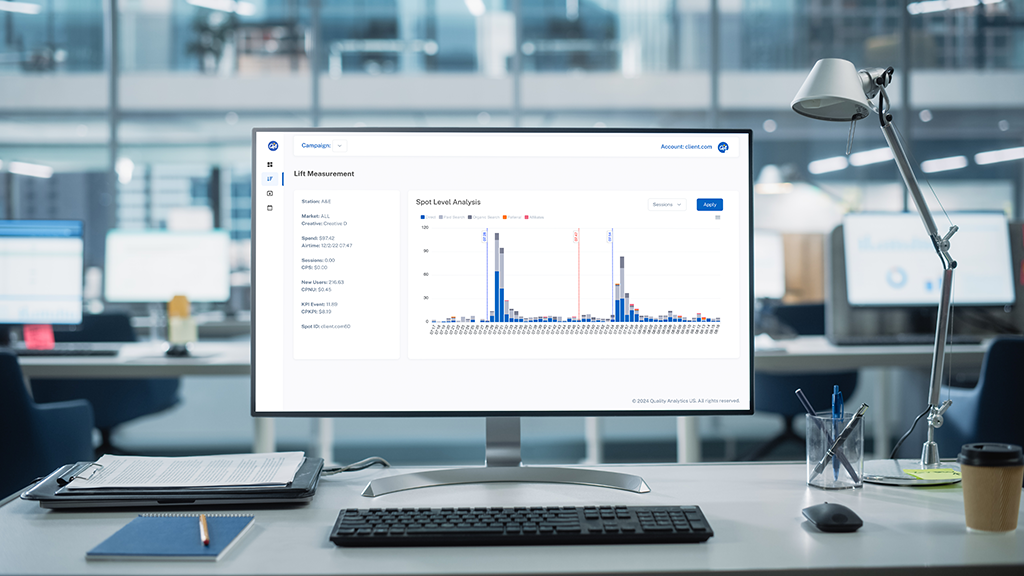Introduction to TV Attribution
Understanding the effectiveness of your advertising campaigns is more crucial than ever. Historically marketers have had few tools to understand the impact of Television and Radio on their end client’s business. Modern TV Attribution emerges as a vital tool in this endeavor, enabling businesses to measure the impact of television commercials on their online outcomes. Whether you’re a seasoned marketer or just beginning your journey, grasping the concept of TV Attribution can significantly enhance your marketing strategies and drive better results.
Understanding TV Attribution
When we discuss TV Attribution, we’re referring to the process of assigning credit to television commercials for specific benefits or responses, such as website visits, online purchases, or brand engagement. This practice helps businesses determine the effectiveness of their TV marketing efforts in driving online engagement and sales, providing a clear picture of ROI from TV advertising.
Confusion with Online “Attribution”
At its essence, the word attribution means assigning credit. For TV marketers this means assigning the incremental benefit of a TV commercial back to that TV commercial. In the digital marketing world attribution means “re-assigning” credit from one sale for example to many marketing touchpoints on a fractional basis. This is where the first source of confusion comes in to play. When you research TV attribution, you are invariable presented with concepts from the digital marketing industry which mean something completely different to TV and Radio marketers. The best way to think about it is that in the digital marketing world, assigning a visit to a website is already known. There is no need to guess, much less for a complex solution to understand that a click with well defined “url parameters” such as utm codes and click_ids. In the offline world, this first assignment of credit is completely unknown. Same word to two different people means something completely different.
Common Pseudonyms for TV Attribution
TV Attribution is known by various other terms in the industry but essentially they all refer to the same topic.
- TV Analytics
- TV Spike Analysis
- Burst Analytics
- Lift Analytics
- TV Advertising Analytics
- Linear TV Attribution
- TV Data Analysis
- TV Commercial Analysis
These terms are often used interchangeably, but they all revolve around the central theme of measuring and understanding the impact of TV advertising on consumer behavior.
The Benefits of TV Attribution
The benefits of having a TV attribution system are many. Without a systematic approach to quantifying the benefit of TV marketing, you’re basically in the dark. Here are the most important benefits.
-
Eliminate Wasted Ad Spend:
Not all TV commercials will work for all advertisers and brands. It is foolish to think that a specified number of impressions or “reach” will benefit two different brands equally. In most cases a commercial will either be beneficial or not provide a benefit to the intended brand. By knowing which commercials work and those that don’t advertising agencies can eliminate wasted ad spend. -
Higher Return on Ad Spend (ROI):
Similarly, by knowing which commercials work and those that don’t advertising agencies can increase the return on investment from their marketing spend. -
Bigger Marketing Budgets and Increased Confidence:
When an advertising agency end client knows that the advertising agency has a systematic approach to measuring the benefit of their ad dollar, they typically are more comfortable increasing budgets. Imagine for example that a digital marketing campaign was unquantifiable, any brand would be more skeptical of investing were this to be the case. Adding transparency and repeatability to TV marketing grows confidence and media budgets. -
Better Negotiated Ad Rates:
Advertising agencies buy their TV inventory from stations whom in a sense are pricing the media based on the same impressions and “reach” calculations as everyone else. When TV is quantifiable for a specific brand, the advertising agency generates an advantage to negotiate the cost of media based on its incremental benefit to the end client. -
Identify Media That Did Not Air:
One of the best reasons to measure TV marketing with a TV Attribution tool is to identify and notice when media does not air. Especially for expensive airings that always produce a “lift”. Quickly noticing that the benefit of a spot was 0 is a sure clue that the airing may not have run on schedule for a variety of reasons. Without a TV attribution solution, this type of scenario can go unnoticed to the detriment of the paying client.
Traditional Methods of TV Attribution
Historically, attributing online actions to TV commercials has been challenging. Traditional methods often relied on broad assumptions, making it difficult to pinpoint the exact impact of individual TV spots. See our full article on why these methods are not sufficient in today’s world Traditional TV Attribution Methods.
- Surveys and Focus Groups: Gathering consumer feedback to gauge the influence of TV ads.
- Correlation Analysis: Looking for patterns between TV ad airings and online activity.
- Incremental Sales Tracking: Measuring overall sales increases during ad campaigns.
- 800 Numbers: Providing unique phone numbers in TV ads to track call volumes directly attributed to specific commercials.
- Vanity URLs and Vanity Domains: Using memorable and specific URLs in ads to monitor website traffic originating from TV spots.
- Offer Codes or Discount Codes: Including unique codes in TV commercials that customers can use online or in-store, allowing businesses to track the source of sales.
- Self Reported Surveys: A drop down or question asking the user where they heard about the brand. There are three main challenges with this approach. First, users are not incentivized to answer correctly, often choosing the first option in the list. Second, a list of options will never be as granular as the full list of TV ads that aired, often the option is reduced to “TV” effectively blending the entire media campaign into one response. Third, in the case of where a user was influenced by multiple marketing touch points, they are limited to choosing one response.
How TV Attribution Works
At Quality Analytics, we’ve revolutionized TV Attribution by combining advanced data science, granular website data and traditional media campaigns. Our comprehensive approach ensures precise measurement and actionable insights, empowering businesses to optimize their TV marketing strategies effectively.
Granular Website Data
We start with detailed website data from sources like Google Analytics, focusing on metrics at the minute level, geography and market level, and by marketing channel. This granular approach allows us to detect minute-by-minute changes in website activity, providing a clear picture of how TV commercials influence online behavior.
Filter for Relevant Website Traffic
Our process involves two key filtering steps:
- Marketing Channel Pre-Filtering: We filter out marketing channels that are not viable for TV attribution, ensuring that only relevant data is analyzed. This typically includes only Organic Search, Direct, Paid Search marketing channels but can also include Cross Network and Unassigned.
- Geographical Filtering: We narrow down the data to the specific geographies where the TV ads were aired, whether it’s a national campaign across the United States or targeted regional spots.
- Review and Troubleshoot Google Analytics Issues: For most companies, Google Analytics has evolved over many years with varying levels of accuracy. It’s very common to have tagging problems at the website domain, page or click tagging levels. One of the strongest benefits of working with Quality Analytics is the wide range of experience in web analytics. We are happy to help all new customers better their Google Analytics ecosystem.
Spike Analysis: Detecting the Lift
The cornerstone technique in our TV Attribution toolkit is Spike Analysis. When a TV commercial airs, it typically generates a spike—a sudden increase—in website activity. Here’s how we identify and measure this lift:

- Historical Data Comparison: For example, if an ad runs at 10:05 PM on a Tuesday, we use historical data from Tuesdays at the same time to forecast expected website activity. We exclude historical data where other ads have ran such that we identify those traffic patterns as not normal.
- Create a Micro Forecast For Each Ad: Once we have historical data cleaned and ready, an advanced minute level forecast is created for each ad. This is what should have happened in the absence of a TV ad.
- Forecast vs. Actual: We compare the forecasted activity with the actual data post-ad airing to identify the spike.
- Mathematical Algorithms: Our proprietary algorithms calculate the lift by measuring the difference between expected and actual website activity, isolating the impact of the TV commercial.
Managing Multiple Ad Spots
Television commercials often run multiple times a day, sometimes in quick succession. Our system handles this by modeling the immediate and decaying responses to each ad:

- Immediate Impact Identification: We assess the direct impact of each ad spot within a close timeframe.
- Decay Modeling: We analyze how the lift from each ad decays over time, allowing us to share credit accurately among multiple spots.
- Credit Allocation: For instance, if three ads air within a 10-minute window, our system distributes the lift based on the decay patterns, ensuring each ad receives appropriate credit.
Optimizing Media Planning Strategies
Quality Analytics‘ TV attribution method seamlessly integrates with media planning strategies, enhancing your overall marketing approach:

- The First Goal: Stop spending media budget on portions of the media plan that has a higher cost-per-action than the average for the campaign.
- The Second Goal: Start spending media budget on portions of the media plan that has a higher cost-per-action than the average for the campaign.
- In-Flight Optimization: Quality Analytics allows advertisers to monitor campaign performance throughout its duration. By analyzing near real-time data on ad effectiveness, they can make adjustments mid-campaign to optimize placements and creatives for better results. Our reporting allows you to make decisions based on Station, Creative, Creative Length, Format, Network, Market, and Publisher performance.
- Long-Term Strategic Decisions: The data collected through Quality Analytics can inform future media buying decisions. By understanding what content resonates with viewers and drives conversions, advertisers can find new TV stations that compliment their media strategy for long-term success.
Conclusion
TV Attribution is a game-changer for businesses looking to maximize the impact of their television advertising. By leveraging sophisticated TV Attribution, Quality Analytics provides a clear and precise understanding of how TV commercials drive online engagement and sales. Embrace the power of accurate TV Attribution to elevate your marketing strategies and achieve your business goals.
For more information on how our TV Attribution solutions can transform your marketing efforts, contact us today!
Want to learn more? See these resources from around the web:
Attribution (marketing) – Wikipedia
https://en.wikipedia.org/wiki/Attribution_(marketing)
Television advertisement – Wikipedia
https://en.wikipedia.org/wiki/Television_advertisement
TV-Attribution-Provider-Guide-2019.pdf
https://cimm-us.org/wp-content/uploads/2019/02/TV-Attribution-Provider-Guide-2019.pdf
Advanced_TV_Attribution_IAB_Video_CoE_2018-10.pdf
https://www.iab.com/wp-content/uploads/2018/10/Advanced_TV_Attribution_IAB_Video_CoE_2018-10.pdf
